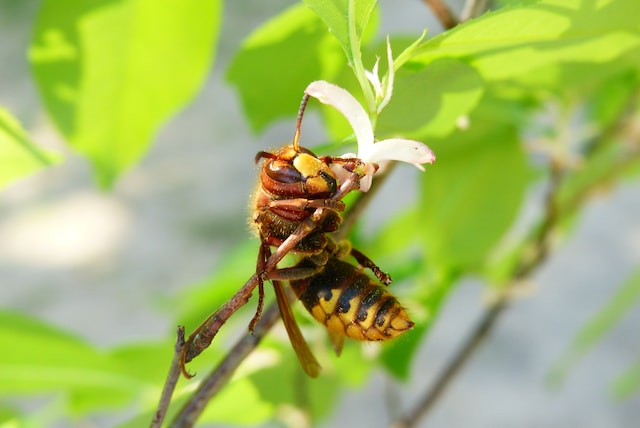As summer approaches, many people look forward to enjoying the warm weather and outdoor activities. However, it’s also the season when hornets become more active and potentially threaten humans.
Understanding the anatomy of these insects is crucial for effective pest control, as it can help identify the species and choose the best methods to combat them. In this blog, we’ll take a closer look at the anatomy of a hornet and discuss how this knowledge can benefit you and the pest control experts.
European Hornets: An Overview
First, let’s clarify what makes a true hornet. While the term “hornet” is often used loosely to refer to any giant, stinging insect, not all insects in this category are true hornets. Bald-faced hornets, for example, are a type of yellowjacket wasp, despite their misleading name.
When it comes to stinging insects, hornets are often considered some of the most intimidating. Unlike smaller wasps, hornets have a distinctive appearance that sets them apart. With their large bodies and powerful stingers, they can strike fear into even the bravest of hearts.
But what exactly makes hornets so different from other types of wasps? For starters, their size is a significant factor. European hornets, for example, can grow up to 1.5 inches in length, which is significantly larger than most other wasps you’ll find in the United States.
They are also relatively stocky, with broad bodies and thick, mighty wings that enable them to fly at high speeds and cover long distances.
Another key difference is their behavior. While some wasps are known for being aggressive, hornets are particularly notorious for their territorial nature.
They will actively defend their nests against perceived threats, including humans who unknowingly come too close. This can make them particularly dangerous if you stumble upon a nest accidentally. So steer clear of any buzzing pests you may see during warm weather seasons!
Anatomy of a Hornet
Like all insects, European hornets have a head, thorax, and abdomen, each serving a specific purpose. Their head contains their brain, eyes, antennae, and mouthparts, which they use to navigate their environment, detect prey, and feed.
Their thorax is the middle section of their body, where their wings and legs are attached, allowing them to fly and walk on various surfaces. A hornet’s abdomen contains its digestive system, reproductive organs, and stinger.
One of the most remarkable aspects of the anatomy of a hornet is its stinger. Unlike honeybees, European hornets have smooth stingers that can be used repeatedly without harming the insect.
This allows them to defend themselves and their colony against predators and other threats without sacrificing their lives.
Another interesting feature of European hornets is their eyes. Like many insects, European hornets have compound eyes, allowing them to see in multiple directions and detect movement over a wide field of view. This makes them highly effective at hunting and navigating their environment, even in low-light conditions.
European hornets also have powerful jaws to bite and tear apart their prey, including pollen and other sweet substances like fruit, soft drinks, nectar, and juice.
But that doesn’t mean the other insects on your property are safe! Hornets target a variety of insects and arthropods for the hive’s young. They’re particularly fond of honeybees and other flying insects, often decimating local insect populations to feed the growing larvae.

Overall, European hornets are a formidable and fascinating insect species with a range of unique features and adaptations that make them well-suited to their environment. The anatomy of a hornet can protect it from foes and even lend a hand for food collection.
However, if you suspect a European hornet infestation on your property, it’s essential to seek professional pest control services to safely and effectively remove the insects and prevent future problems.
Hornet Anatomy and Pest Control
For pest control experts, understanding the anatomy of a hornet is critical in identifying the species we’re dealing with and selecting the most effective methods to control them.
For example, the European hornet’s unique yellow and black striped abdomen distinguishes it from others. Its head is also distinct, featuring large compound eyes and two antennae that allow it to sense its surroundings and communicate with other hornets.
European hornets have a robust and serrated stinger to defend their nests against potential predators. Knowing this, pest control experts can take extra precautions when approaching an infested area to ensure their safety and the safety of others.
With this knowledge of their behavior and appearance, we can easily discern between different wasp species in your yard and keep you safe from errant stinging pests.
Are you dealing with a hornet infestation in your home or business? Don’t wait until it’s too late. Contact the experts at proof. Pest Control today, and let us help you eliminate these dangerous pests for good.
Our team of experienced professionals knows the ins and outs of hornet control and can provide customized solutions to meet your unique needs. Contact us now to schedule a consultation and take the first step towards a hornet-free environment.

